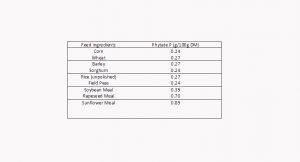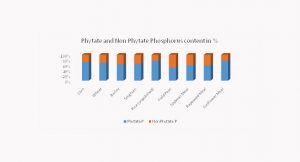 Feb 1,2020
Feb 1,2020

Phytate is the major form of phosphorus present in grains and oilseed meals, used in poultry diet. Poultry birds are unable to utilize phytate due to lack of endogenous phytase enzyme.
Phytate Phosphorus content of various feed ingredients:

Given in the graph below is the portion of phytate and non-phytate phosphorus in major feed ingredients.

Phytate Phosphorus largely undigested in poultry is excreted in the manure which leads to soil and water pollution. Phytate also has the ability to bind with other metal ions (e.g. Ca+2 , Mg+2 ,Zn+2 ,Fe+2 ) and proteins which get eventually excreted unutilized.
To meet the phosphorus requirements of poultry birds, inorganic form of phosphorus is added to poultry ration, which is costlier and increases the feed cost.
Phytaseenzymes of microbial origin are being used to release phosphorus from phytates which has beneficial effects on the growth, feed efficiency, protein and amino acid digestibility, energy utilization, mineral retention and bone growth.
Phytase enzyme has been used since long in broiler nutrition. There are several types of phytases available based on their origin, activity and thermostability.
Broiler nutrition, in particular, where feed is in pelleted form, thermostability of phytase is most important criterion to select any phytase.
Earlier, phytases of fungal origin were common in animal nutrition.But, bacterial phytases having many superior features like resistance to proteolysis, high catalytic efficiency and high residual activity after pelleting, they are preferred nowadays.

Among bacterial phytases, E coli origin phytase is considered superior as it is more resistant to endogenous proteases.

Phytase of E. coli origin has significantly higher residual activity after incubating same with endogenous proteases, compared with other bacterial phytase.
Thermostability of Phytase, a zymoprotein depends on its amino acid sequence and spatial conformation. It is the latest trend in protein engineering to modify the amino acid sequence and design the gene mutation in Phytase production to impart heat stability characteristics. Also, genetically modified Phytases possess better catalytic activity. (Singh B. et al, Bioteh. and Mol. Biology Review, March 2011)
Thermostability of genetically modified phytase is better compared to coated forms of phytase.
Comparison of Uncoated, Coated & GM Phytases
Metaphos XT, an E.coliphytase sourced by Avitech and tested for all critical parameters by the Analytical Division (NABL/ISO 17025 accredited) is now available offering enhanced on feed efficiency and performance.
The unique properties of genetically engineered E coli phytase, like intrinsic ability to resist heat and higher resistance to endogenous proteases makes Metaphos- XT a superior choice for commercial feed.